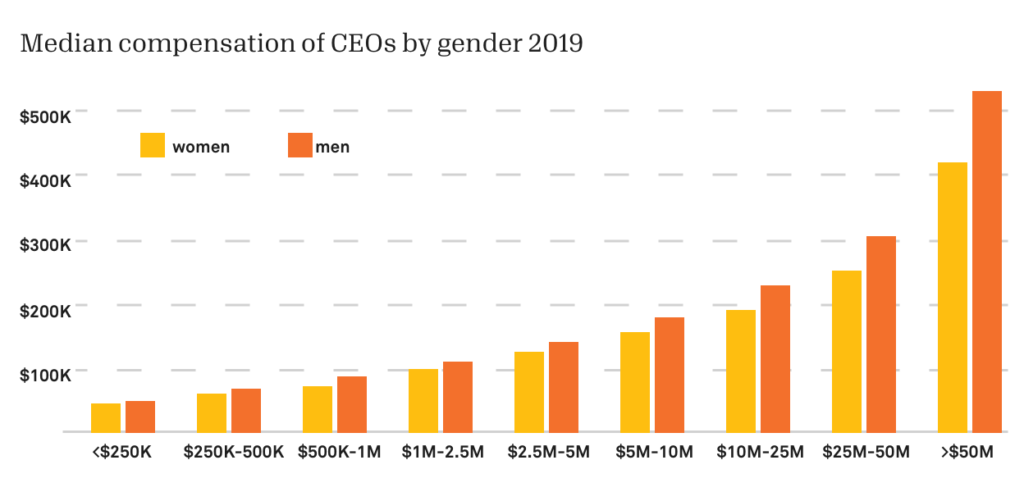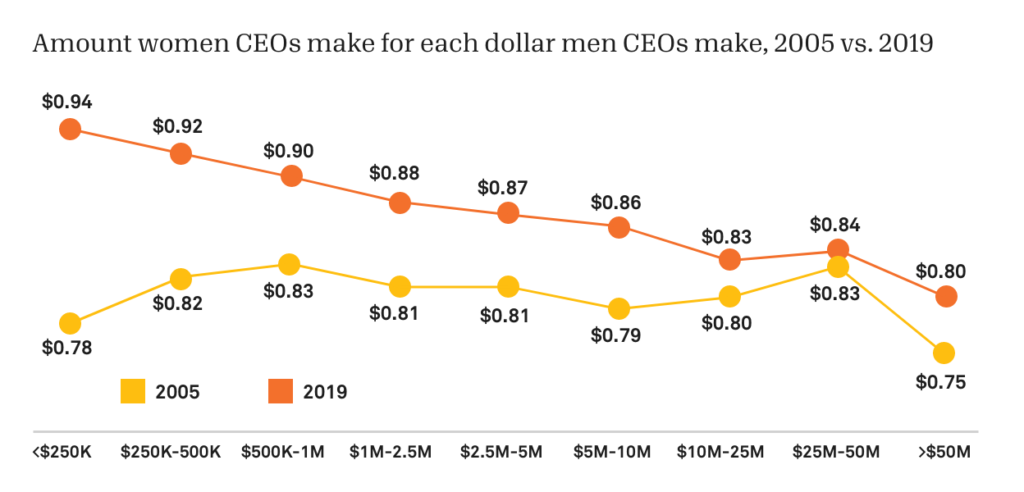Today is U.S. Equal Pay Day—but not for CEOs in the social sector

Today, March 15, is U.S. Equal Pay Day, a day created by the National Committee on Pay Equity to increase awareness about the gender wage gap. Specifically, this symbolic day marks how far into the year a woman must work to receive the same wage that a man received the previous year. This year, women in the U.S. had to work a 14-and-a-half-month year to earn the same amount that men made in 2021. This translates to women making about 83 cents for every dollar made by men (based on median income).
When is U.S. Equal Pay Day for social sector leaders?
Over the years, different equal pay days have been calculated for different industries and populations. In this blog, I examine equal pay day for CEOs and executive directors in the social sector. I followed the same methods1 used to calculate National Equal Pay Day but focused specifically on the total reportable compensation of the 46k women CEOs and 42k men CEOs included in Candid’s most recent Nonprofit Compensation Report2. Results showed that the median compensation for women was $85k and the median compensation for men was $118k. In other words, women at the top of nonprofit organizations make about 72 cents for every dollar made by men. Or put another way: women leading nonprofits worked 102 days a year for free. This means that this year’s Equal Pay Day for nonprofit CEOs falls on May 24, 2022.
This is largely consistent with last year’s analysis, when the nonprofit CEO equal pay day fell on June 8, 2021. Across both years of data, the nonprofit CEO pay disparity is substantially larger than the gender pay gap in the U.S workforce overall. The disparity appears to be largely driven by three key differences:
- Men are more likely to lead larger organizations.
- Larger organizations tend to have higher compensation.
- The gender compensation gap is larger in larger organizations.
Let’s unpack these differences further. Within Candid’s dataset, men-led organizations are twice the size of women-led organizations. Specifically, the median annual expenses for organizations with men CEOs is $1.8 million, while median expenses for organizations with women CEOs is $963k. Given that there is a strong correlation between organizational expense size and CEO compensation package (see chart below), it might not be surprising that men CEOs enjoy higher pay. However, organization size alone doesn’t account for the gender compensation gap. This gap persists at every organization size and is the widest among the largest organizations. As an example, among organizations with expenses above $50 million, women CEO median compensation is $426,467, while men CEO compensation is $533,615. That’s a six-figure pay cut for women—per year.

Does the pay gap persist everywhere in the sector?
I was also curious whether the CEO gender pay gap is found throughout the social sector. The short answer is yes—*practically* every way I cut the data, the gender gap persisted. In 39 out of 40 organization types examined, women made less than men—between 44.9 cents to 97 cents. The one exception to the rule was fraternal beneficiary societies and associations (501c8s), in which women made 1.44 dollars for every dollar made by men. Here are the top 5 subsectors for which women CEOs made the least compared to men in their subsector.

Equal Pay Days for social sector CEOs in these subsectors would fall somewhere between November…and sometime in early 2023 (yikes).
Is the gender pay gap closing in the social sector?
This year’s analysis suggests a small step toward pay parity. After all, May 24 is earlier in the year than June 8. We should commend and celebrate this small movement. Indeed, the whole point of Equal Pay Day is to give us a way to collectively countdown to parity. However, it’s also worth reflecting on just how far we have to go until we reach equal pay in our sector, especially within large organizations.
The graph below plots out the CEO gender pay gap in 2005 vs 2019 (our most recent data) across different organization sizes. While there have been major shifts in pay parity among small organizations, there has been almost no movement within large organizations over the 14-year span. In fact, at the current rate of change, this data suggests that it could take between 56 to 224 years3 before men and women are paid equally for leading large nonprofit organizations.

We’re essentially looking at change happening for the generations ahead of us. While it can’t come soon enough, it’s worth investing in your organization’s policies now to ensure equal and fair compensation sooner rather than later.
1 National Equal Pay Day for 2022 was calculated using the median wage for men and women employed full-time and year-round in 2020, according to U.S. Census Bureau data. These median wages are then used to calculate how many days into the new year women must work to reach pay parity. Each year, a Tuesday or Wednesday near this date is selected to observe Equal Pay Day. Because the day is symbolic, it may deviate slightly from the date calculated to accommodate holidays and other observances. We replicated this procedure using 2019 data from Candid’s 2021 Nonprofit Compensation Report to come up with the numbers and dates referenced in this post.
2 This dataset draws from data reported on IRS Forms 990 and 990-EZ. Because these forms do not include wage information for all staff, we limited our analyses to organizational leader and total compensation. For more information see Candid’s 2021 Nonprofit Compensation Report methodology.
3 Based on this data, it will take 56 years to close the gender pay gap in organizations with expenses above 50 million, and 224 years for organizations with expenses between 25-50 million.







Vivian Christine Powell says:
I WANT IT TO BE PUBLISHED! The wage GAP has been this way for years and no one really acknowledges the fact that 94% of women are the head of their household and that is ridiculous. Not only that, man do not do half the work that women do, women are more responsible, equipped, dedicated, motivated, leaders, and most of all women empower each other while all men think about is staying in POWER.
The Nerve of them, they can't even run their household as great as women, they can't carry a baby for 9 months and deal with the labor as women can. All they want women to do is sit down and do as they are told... That crap is over! PAY WOMEN THEIR WAGES NOW!